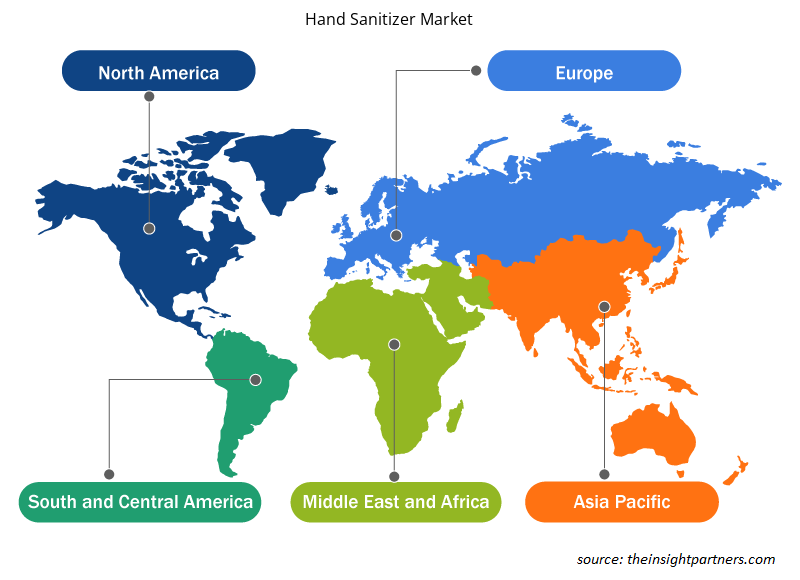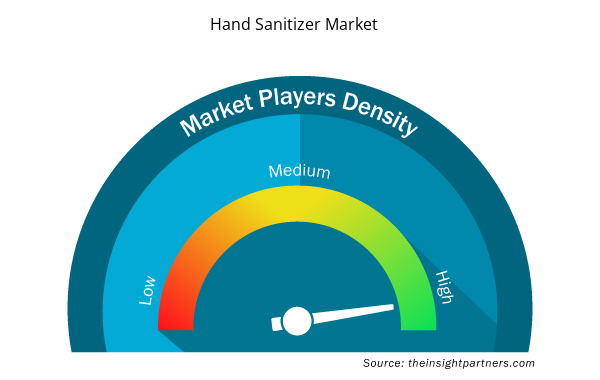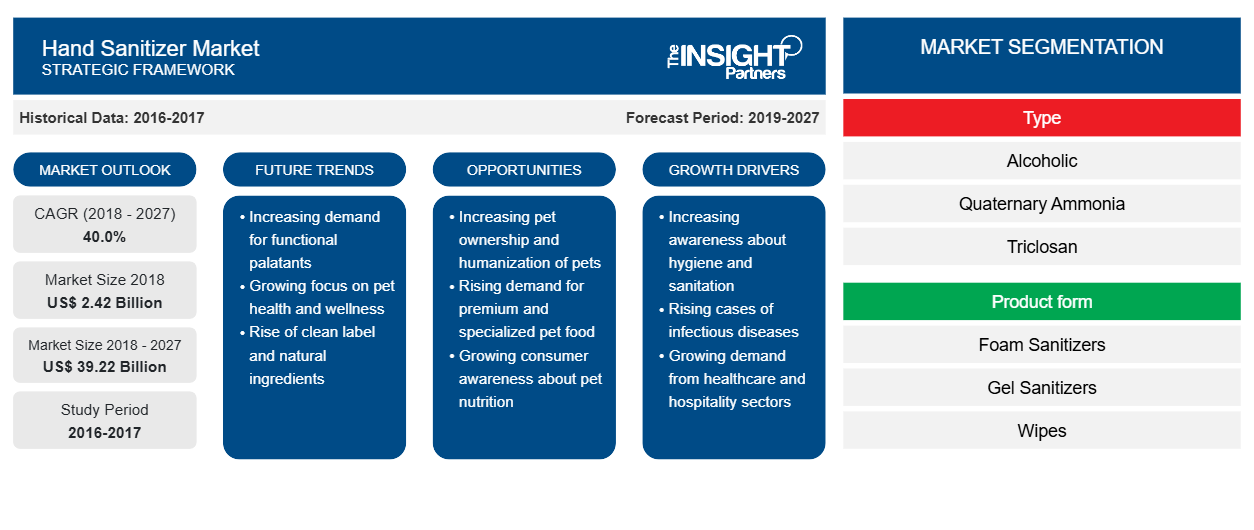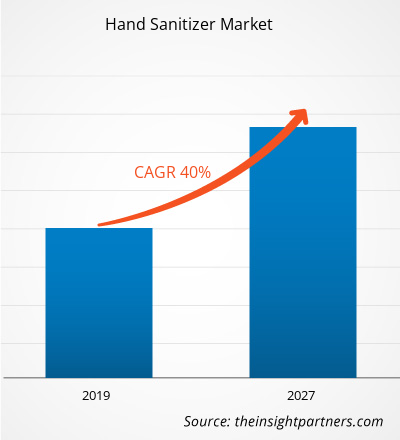2018 年洗手液市场价值为 24.211 亿美元,预计到 2027 年将达到 392.231 亿美元,预测期内复合年增长率为 40.0%。
洗手液,又称洗手液和洗手消毒剂,用于中和皮肤表面的细菌和微生物。它们经常用于职业和医疗保健环境中,因为在这些环境中传播传染性病原体的风险要高得多。洗手液的功效取决于各种因素,例如洗手液的用量、使用频率、接触时间。然而,洗手液并不能代替彻底洗手。相反,人们认为,当洗手不方便时,洗手液可以为用户带来洗手的一些好处。人们对手部卫生的认识不断提高、生活水平的提高以及对健康的日益关注,导致了对洗手液的大量需求。洗手液的使用已在许多公共场所变得无处不在,包括健身房、餐馆、医院、工厂、办公室、商场、电影院等。洗手液的普遍使用可能会为洗手液行业带来重大机遇。洗手液使用方便,可随身携带,在学龄儿童中很受欢迎。医疗保健行业是洗手液的一大消费领域,为洗手液行业创造了可观的收入。流感和其他传染病的频繁爆发是洗手液产品需求不断增长的因素之一。
定制此报告以满足您的需求
您可以免费定制任何报告,包括本报告的部分内容、国家级分析、Excel 数据包,以及为初创企业和大学提供优惠和折扣
- 获取此报告的关键市场趋势。这个免费样品将包括数据分析,从市场趋势到估计和预测。
市场洞察
消费者对保持健康和卫生的意识不断增强
北美、欧洲和亚太地区大多数发达国家和发展中国家的消费者都非常关注保持健康和卫生的生活方式。
通过手掌和手部传播的细菌通过口腔、鼻子、皮肤裂口和眼睛进入人体。这些细菌会引起各种疾病,包括皮肤感染、眼部感染、感冒、胃痛等。为了预防这些疾病,洗手液可以杀死高达 99% 的细菌和病毒,起到很大的作用。洗手液有液体、喷雾和湿巾形式,用于减少手上的传染源。除了生活方式和慢性疾病外,感冒、发烧、感染也是消费者中常见的疾病;因此人们非常关注预防这些疾病。各种非政府组织也在积极努力教育偏远地区的人们保持健康和卫生。除此之外,洗手液主要制造商的营销和促销活动在提高消费者意识方面发挥着重要作用。这些因素推动了洗手液市场的增长。
类型洞察
根据制备洗手液所用化学品的不同,全球洗手液市场主要分为三种类型,即酒精型、季铵型和三氯生型。2018 年,酒精型洗手液占据了全球洗手液市场的较大份额。不过,预计在预测期内,季铵型洗手液的复合年增长率将达到最快。季铵化合物是一种强效消毒化学品,常用于消毒湿巾、喷雾剂和其他家用清洁剂中,用于杀死细菌。这些化合物对细菌、酵母、霉菌和病毒非常有效。它们无腐蚀性,不会引起皮肤刺激,而且非常稳定。季铵基消毒剂足够稳定,无论使用频率如何,都不会随着时间的推移而失去杀死细菌的效力。由于季铵具有成本效益,许多制造商在生产洗手液时都在使用它。这些因素正在影响季铵盐类洗手液市场的增长。
产品形态洞察
根据产品形式,全球洗手液市场细分为泡沫洗手液、凝胶洗手液、湿巾和喷雾洗手液。2018 年,凝胶洗手液占据洗手液市场最高市场份额,预计在预测期内将继续保持主导地位。然而,泡沫洗手液预计将以最快的复合年增长率增长。泡沫洗手液的真正优势在于,在使用过程中,产品会粘在手上。这种泡沫洗手液不会像凝胶洗手液那样容易从手上滑落。制造商为消费者提供的泡沫洗手液大多不含酒精。这些洗手液可杀死 99.9% 的最常见细菌,让您的双手保持清洁柔软。日托中心、健身中心、医院、厨房台面、学校和办公室周围等场所对这些产品的需求日益增长。
应用程序洞察
根据应用,全球洗手液市场分为医院、餐馆、教育机构、家庭和其他。2018 年,医院部门以较高的份额引领了洗手液市场,预计在预测期内将继续占据主导地位。洗手液在全球所有医院和诊所中广泛使用,这推动了该市场的发展。在世界各地的医院,工作人员尽职尽责地涂抹洗手液以防止感染扩散。洗手液计量系统和分配器用于手术手部消毒。医院推荐使用含酒精的洗手液,并广泛使用。消毒剂作为预防措施的日益普及已被确定为推动市场增长的关键洗手液市场趋势之一。
分销洞察
全球洗手液市场进一步细分为超市和大卖场、便利店、线上等分销渠道。大卖场和超市部门在全球洗手液市场中占有最高市场份额,预计在预测期内将继续保持主导地位。大卖场和超市是自助商店,提供各种各样的洗手液产品,如泡沫消毒剂、凝胶消毒剂、湿巾和喷雾消毒剂。这些种类繁多的产品以非常有组织的方式摆放在不同的区域和货架上,以吸引顾客。与其他分销渠道相比,这类商店在一个地方为消费者提供来自不同品牌的广泛产品选择,而且价格实惠。此外,类似的产品排列在附近,让买家在购买合适的产品之前,可以方便地比较不同的产品。这些地方的客流量不断增加,尤其是注重健康的买家,再加上各种品牌的洗手液产品以实惠的价格广泛供应,鼓励了顾客从大卖场和超市购买洗手液。
汉高股份公司、KGAA、利洁时集团、艺康、GOJO Industries, Inc. 等公司一直在实施各种战略,这些战略促进了公司的发展,进而带来了市场的各种变化。并购和产品发布是一些市场举措,这些举措是这些公司为扩大市场份额而采取的一些活动。产品发布和并购等战略帮助他们发展了业务。
洗手液市场区域洞察
Insight Partners 的分析师已详尽解释了预测期内影响洗手液市场的区域趋势和因素。本节还讨论了北美、欧洲、亚太地区、中东和非洲以及南美和中美洲的洗手液市场细分和地理位置。

- 获取洗手液市场的区域特定数据
洗手液市场报告范围
| 报告属性 | 细节 |
|---|---|
| 2018 年市场规模 | 24.2亿美元 |
| 2027 年市场规模 | 392.2亿美元 |
| 全球复合年增长率(2018 - 2027) | 40.0% |
| 史料 | 2016-2017 |
| 预测期 | 2019-2027 |
| 涵盖的领域 | 按类型
|
| 覆盖地区和国家 | 北美
|
| 市场领导者和主要公司简介 |
|
洗手液市场参与者密度:了解其对业务动态的影响
洗手液市场正在快速增长,这得益于终端用户需求的不断增长,这些需求源于消费者偏好的不断变化、技术进步以及对产品优势的认识不断提高等因素。随着需求的增加,企业正在扩大其产品范围,进行创新以满足消费者的需求,并利用新兴趋势,从而进一步推动市场增长。
市场参与者密度是指在特定市场或行业内运营的企业或公司的分布情况。它表明在给定市场空间中,相对于其规模或总市场价值,有多少竞争对手(市场参与者)存在。
在洗手液市场运营的主要公司有:
- 汉高股份公司
- 联合利华
- 喜马拉雅制药公司
- 艺康
- 3M
免责声明:上面列出的公司没有按照任何特定顺序排列。

- 获取洗手液市场顶级关键参与者概览
洗手液市场 - 按类型
- 酒精
- 季铵盐
- 三氯生
洗手液市场 - 按产品形式
- 泡沫消毒剂
- 凝胶消毒剂
- 湿巾
- 喷雾消毒剂
洗手液市场 - 按应用分类
- 医院
- 餐厅
- 教育机构
- 家庭
- 其他的
洗手液市场 - 按分销渠道
- 超市/大卖场
- 便利店
- 在线的
- 其他的
洗手液市场 - 按地区划分
北美
- 我们
- 加拿大
- 墨西哥
欧洲
- 德国
- 法国
- 英国
- 俄罗斯
- 欧洲其他地区
亚太
- 澳大利亚
- 中国
- 印度
- 日本
- 亚太其他地区
中东和非洲
- 南非
- 沙特阿拉伯
- 阿联酋
- 中东和非洲其他地区
南美洲
- 巴西
- 阿根廷
- 南美洲其他地区
公司简介
- 汉高股份公司
- 利洁时集团
- 3M
- 艺康
- GOJO 工业公司
- 联合利华
- 喜马拉雅制药公司
- Godrej 实业有限公司
- 宝洁
- 庄臣公司
- 历史分析(2 年)、基准年、预测(7 年)及复合年增长率
- PEST 和 SWOT 分析
- 市场规模价值/数量 - 全球、区域、国家
- 行业和竞争格局
- Excel 数据集



Report Coverage
Revenue forecast, Company Analysis, Industry landscape, Growth factors, and Trends

Segment Covered
This text is related
to segments covered.

Regional Scope
North America, Europe, Asia Pacific, Middle East & Africa, South & Central America

Country Scope
This text is related
to country scope.
常见问题
Rising health awareness among the customers, and growing demand of hand sanitizers due to the rise in corona virus in countries like China, Japan, Italy, and UK among others, are one of the key drivers of the global hand sanitizers market.
The fastest growing region is Asia Pacific at a global level. With the increase in population in this region, increasing disposable income, and growth in the education sector, the demand for hand sanitizer has substantially gone up in India, China, and Japan, which is driving the growth of the market. Also, the consumer’s awareness of the uses and benefits of hand sanitizer is also propelling the growth of the market in the region. Also, consumer goods manufacturers are investing in research and development activities to offer innovative and safe hand sanitizers. This has also surged the demand for the product in the region.
In 2018, the alcoholic hand sanitizer segment accounted for a larger share of the global hand sanitizer market. The demand for alcoholic hand sanitizer is increasing from the hospitals and the household sectors. This type of hand sanitizer is generally more effective at killing microorganisms and better tolerated than soap and water. Alcohol rubbing kills many different kinds of bacteria, including antibiotic-resistant bacteria and TB bacteria. The alcohol-based hand sanitizer is on the list of the World Health Organization's essential medicines, as the safest and most effective medicines needed to protect health from germs. Several leaders in the hand sanitizer market are offering alcohol-based hand sanitizers such Reckitt Benckiser Group, Ecolab, The Himalaya Drug Company, B4 Brands, and many others. Ecolab is offering a wide range of hand sanitizers such as gel and foam commercial antibacterial hand sanitizers, advanced gel hand sanitizer, foam hand sanitizer, food service hand sanitizer, gel hand sanitizer, gentle hand sanitizer, instant hand sanitizer, quick care foam hand sanitizer.
Trends and growth analysis reports related to Consumer Goods : READ MORE..
The List of Companies - Global Hand Sanitizer Market
- Henkel AG & Company, KGAA
- Unilever
- The Himalaya Drug Company
- Ecolab
- 3M
- Godrej Industries Limited
- GOJO Industries
- Reckitt Benckiser Group Plc
- Procter & Gamble
- S.C. Johnson & Son
The Insight Partners performs research in 4 major stages: Data Collection & Secondary Research, Primary Research, Data Analysis and Data Triangulation & Final Review.
- Data Collection and Secondary Research:
As a market research and consulting firm operating from a decade, we have published and advised several client across the globe. First step for any study will start with an assessment of currently available data and insights from existing reports. Further, historical and current market information is collected from Investor Presentations, Annual Reports, SEC Filings, etc., and other information related to company’s performance and market positioning are gathered from Paid Databases (Factiva, Hoovers, and Reuters) and various other publications available in public domain.
Several associations trade associates, technical forums, institutes, societies and organization are accessed to gain technical as well as market related insights through their publications such as research papers, blogs and press releases related to the studies are referred to get cues about the market. Further, white papers, journals, magazines, and other news articles published in last 3 years are scrutinized and analyzed to understand the current market trends.
- Primary Research:
The primarily interview analysis comprise of data obtained from industry participants interview and answers to survey questions gathered by in-house primary team.
For primary research, interviews are conducted with industry experts/CEOs/Marketing Managers/VPs/Subject Matter Experts from both demand and supply side to get a 360-degree view of the market. The primary team conducts several interviews based on the complexity of the markets to understand the various market trends and dynamics which makes research more credible and precise.
A typical research interview fulfils the following functions:
- Provides first-hand information on the market size, market trends, growth trends, competitive landscape, and outlook
- Validates and strengthens in-house secondary research findings
- Develops the analysis team’s expertise and market understanding
Primary research involves email interactions and telephone interviews for each market, category, segment, and sub-segment across geographies. The participants who typically take part in such a process include, but are not limited to:
- Industry participants: VPs, business development managers, market intelligence managers and national sales managers
- Outside experts: Valuation experts, research analysts and key opinion leaders specializing in the electronics and semiconductor industry.
Below is the breakup of our primary respondents by company, designation, and region:

Once we receive the confirmation from primary research sources or primary respondents, we finalize the base year market estimation and forecast the data as per the macroeconomic and microeconomic factors assessed during data collection.
- Data Analysis:
Once data is validated through both secondary as well as primary respondents, we finalize the market estimations by hypothesis formulation and factor analysis at regional and country level.
- Macro-Economic Factor Analysis:
We analyse macroeconomic indicators such the gross domestic product (GDP), increase in the demand for goods and services across industries, technological advancement, regional economic growth, governmental policies, the influence of COVID-19, PEST analysis, and other aspects. This analysis aids in setting benchmarks for various nations/regions and approximating market splits. Additionally, the general trend of the aforementioned components aid in determining the market's development possibilities.
- Country Level Data:
Various factors that are especially aligned to the country are taken into account to determine the market size for a certain area and country, including the presence of vendors, such as headquarters and offices, the country's GDP, demand patterns, and industry growth. To comprehend the market dynamics for the nation, a number of growth variables, inhibitors, application areas, and current market trends are researched. The aforementioned elements aid in determining the country's overall market's growth potential.
- Company Profile:
The “Table of Contents” is formulated by listing and analyzing more than 25 - 30 companies operating in the market ecosystem across geographies. However, we profile only 10 companies as a standard practice in our syndicate reports. These 10 companies comprise leading, emerging, and regional players. Nonetheless, our analysis is not restricted to the 10 listed companies, we also analyze other companies present in the market to develop a holistic view and understand the prevailing trends. The “Company Profiles” section in the report covers key facts, business description, products & services, financial information, SWOT analysis, and key developments. The financial information presented is extracted from the annual reports and official documents of the publicly listed companies. Upon collecting the information for the sections of respective companies, we verify them via various primary sources and then compile the data in respective company profiles. The company level information helps us in deriving the base number as well as in forecasting the market size.
- Developing Base Number:
Aggregation of sales statistics (2020-2022) and macro-economic factor, and other secondary and primary research insights are utilized to arrive at base number and related market shares for 2022. The data gaps are identified in this step and relevant market data is analyzed, collected from paid primary interviews or databases. On finalizing the base year market size, forecasts are developed on the basis of macro-economic, industry and market growth factors and company level analysis.
- Data Triangulation and Final Review:
The market findings and base year market size calculations are validated from supply as well as demand side. Demand side validations are based on macro-economic factor analysis and benchmarks for respective regions and countries. In case of supply side validations, revenues of major companies are estimated (in case not available) based on industry benchmark, approximate number of employees, product portfolio, and primary interviews revenues are gathered. Further revenue from target product/service segment is assessed to avoid overshooting of market statistics. In case of heavy deviations between supply and demand side values, all thes steps are repeated to achieve synchronization.
We follow an iterative model, wherein we share our research findings with Subject Matter Experts (SME’s) and Key Opinion Leaders (KOLs) until consensus view of the market is not formulated – this model negates any drastic deviation in the opinions of experts. Only validated and universally acceptable research findings are quoted in our reports.
We have important check points that we use to validate our research findings – which we call – data triangulation, where we validate the information, we generate from secondary sources with primary interviews and then we re-validate with our internal data bases and Subject matter experts. This comprehensive model enables us to deliver high quality, reliable data in shortest possible time.


 获取此报告的免费样本
获取此报告的免费样本